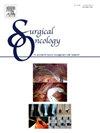80 岁以上口腔鳞状细胞癌患者的治疗策略。
IF 2.3
4区 医学
Q3 ONCOLOGY
引用次数: 0
摘要
研究目的分析年龄≥80岁的口腔鳞状细胞癌患者的临床特征,重点关注手术治疗:我们回顾了 2005 年至 2018 年期间接受手术治疗的年龄≥80 岁的口腔鳞状细胞癌患者。对基本信息、合并症、多种原发癌、初始治疗、并发症和预后进行评估:在197名年龄≥80岁的患者中,119名患者接受了手术(男性50人,女性69人;平均年龄:83.5岁)。牙龈是最常见的原发肿瘤部位(63 名患者,52.9%)。35名患者(29.4%)分期为I期,44名患者(37%)分期为II期,16名患者(13.4%)分期为III期,22名患者(18.5%)分期为IVA期,2名患者(1.7%)分期为IVB期。112名患者(94.1%)有合并症。111名患者(93.3%)接受了手术治疗。8名患者(6.7%)接受了术后辅助化疗/放疗;20名患者(16.8%)接受了游离组织移植。36名患者(30.3%)出现了围手术期并发症。5年和10年累积总生存率分别为82%和68.3%;疾病特异性生存率为90%:结论:根治性手术取得了良好的治疗效果。如果患者的生活质量有保证,且不存在手术耐受性问题,无论年龄大小,都应首选手术治疗。本文章由计算机程序翻译,如有差异,请以英文原文为准。
Treatment strategies for patients over 80 years of age with oral squamous cell carcinoma
Objective
To analyze the clinical characteristics of patients with oral squamous cell carcinoma aged ≥80 years, focusing on surgical treatments.
Study design
We reviewed patients with oral squamous cell carcinoma aged ≥80 years who underwent surgery between 2005 and 2018. Basic information, comorbidities, multiple primary cancers, initial treatment, complications, and outcomes were evaluated.
Results
Of 197 patients aged ≥80 years, 119 patients underwent surgery (50 males, 69 females; mean age: 83.5 years). The gingiva was the most common primary tumor site (63 patients, 52.9 %). The stage classification was stage I in 35 patients (29.4 %), stage II in 44 (37 %), stage III in 16 (13.4 %), stage IVA in 22 (18.5 %), and stage IVB in 2 (1.7 %). Comorbidities were identified in 112 patients (94.1 %). Surgery was the initial treatment in 111 patients (93.3 %). Eight (6.7 %) patients received postoperative adjuvant chemotherapy/radiotherapy; 20 patients (16.8 %) underwent free tissue transplantation. Perioperative complications were observed in 36 patients (30.3 %). The cumulative 5-year and 10-year overall survival rates were 82 % and 68.3 %, respectively; the disease-specific survival rates were 90 %.
Conclusion
Good treatment outcomes were obtained with radical surgery. Surgery should be the first choice if quality of life is assured and there are no issues with surgical tolerance, regardless of age.
求助全文
通过发布文献求助,成功后即可免费获取论文全文。
去求助
来源期刊

Surgical Oncology-Oxford
医学-外科
CiteScore
4.50
自引率
0.00%
发文量
169
审稿时长
38 days
期刊介绍:
Surgical Oncology is a peer reviewed journal publishing review articles that contribute to the advancement of knowledge in surgical oncology and related fields of interest. Articles represent a spectrum of current technology in oncology research as well as those concerning clinical trials, surgical technique, methods of investigation and patient evaluation. Surgical Oncology publishes comprehensive Reviews that examine individual topics in considerable detail, in addition to editorials and commentaries which focus on selected papers. The journal also publishes special issues which explore topics of interest to surgical oncologists in great detail - outlining recent advancements and providing readers with the most up to date information.
 求助内容:
求助内容: 应助结果提醒方式:
应助结果提醒方式:


